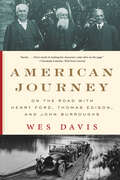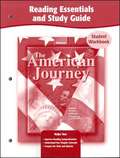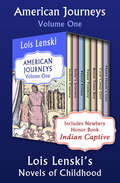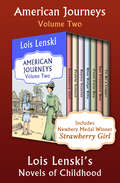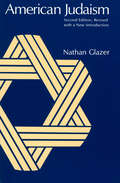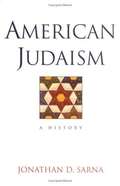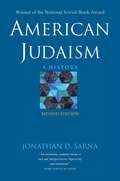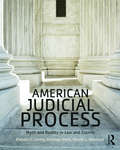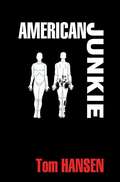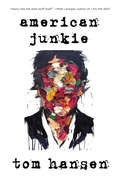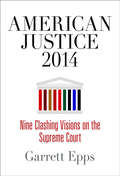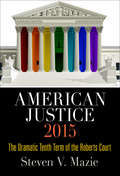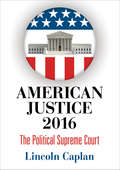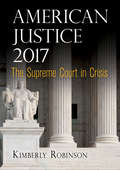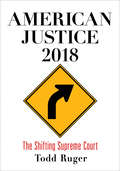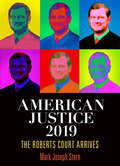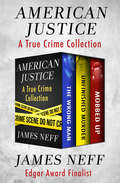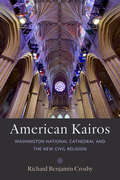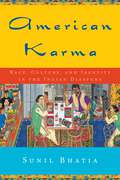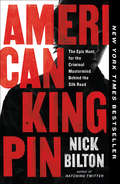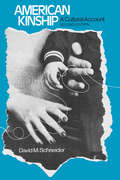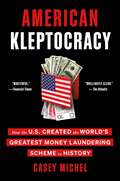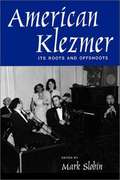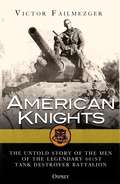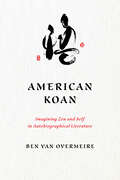- Table View
- List View
American Journey: On The Road With Henry Ford, Thomas Edison, And John Burroughs
by Wes Davis“Jaunty.… Davis excels in making his characters come alive on the page.” —Christoph Irmscher, Wall Street Journal The epic road trips—and surprising friendship—of John Burroughs, nineteenth-century naturalist, and Henry Ford and Thomas Edison, inventors of the modern age. In 1913, an unlikely friendship blossomed between Henry Ford and famed naturalist John Burroughs. When their mutual interest in Ralph Waldo Emerson led them to set out in one of Ford’s Model Ts to explore the Transcendentalist’s New England, the trip would prove to be the first of many excursions that would take Ford and Burroughs, together with an enthusiastic Thomas Edison, across America. Their road trips—increasingly ambitious in scope—transported members of the group to the 1915 Panama–Pacific International Exposition in San Francisco, the Adirondacks of New York, and the Green Mountains of Vermont, finally paving the way for a grand 1918 expedition through southern Appalachia. In many ways, their timing could not have been worse. With war raging in Europe and an influenza pandemic that had already claimed thousands of lives abroad beginning to plague the United States, it was an inopportune moment for travel. Nevertheless, each of the men who embarked on the 1918 journey would subsequently point to it as the most memorable vacation of their lives. These travels profoundly influenced the way Ford, Edison, and Burroughs viewed the world, nudging their work in new directions through a transformative decade in American history. In American Journey, Wes Davis re-creates these landmark adventures, through which one of the great naturalists of the nineteenth century helped the men who invented the modern age reconnect with the natural world—and reimagine the world they were creating.
American Journey: Reading Essentials and Study Guide
by Mcgraw-Hill StaffStudy guide accompanying the high school history textbook.
American Journeys Volume One: Lois Lenski's Novels of Childhood (American Journeys #1)
by Lois LenskiFrom a Newbery Award–winning author: Seven beloved classics that beautifully capture growing up and overcoming challenges across America. In her Newbery Honor Book, Indian Captive, and her Regional America series, six of which are collected here, author/illustrator Lois Lenski presents realistic portrayals of unforgettable young people facing hardships in a range of areas across the country. Based on a true story, Indian Captive tells the compelling chronicle of a twelve-year-old girl kidnapped by the Shawnee in 1758 Pennsylvania. Beginning with the Children’s Book Award winner Judy’s Journey, Lenski depicted kids’ experiences in different regions of mid-twentieth-century America—from East Coast migrant workers to a Texas girl whose family is dealing with drought, from an eleven-year-old boy in oil-boom Oklahoma to the daughter of coal miners in West Virginia, from a family in a flooded western Connecticut town to an African American girl in the 1950s coping with moving north with the help of her loving grandmother. Beyond changing the face of children’s literature, Lenski’s stories continue to endure because of their moving and believable depictions of young people from often overlooked communities. Through her art, Lenski gave these characters a voice that still rings loud and clear for modern readers. This ebook includes Indian Captive, Judy’s Journey, Flood Friday, Texas Tomboy, Boom Town Boy, Coal Camp Girl, and Mama Hattie’s Girl.
American Journeys Volume Two: Lois Lenski's Novels of Childhood (American Journeys #2)
by Lois LenskiFrom a Newbery Award–winning author: These seven beloved classics beautifully capture growing up and overcoming challenges across America. In her Regional America series, author and illustrator Lois Lenski presents realistic portrayals of unforgettable young people facing hardships and triumphs across the diverse United States. The Newbery Medal–winning Strawberry Girl follows day-to-day life for Birdie and her family on a berry farm in Florida, as they deal with heat, droughts, cold snaps, and difficult neighbors. In Prairie School, a young girl gets stranded at her South Dakota school by a winter storm; in Bayou Suzette, the Cajun Suzette strikes up an unlikely friendship with a Native American girl in the swamps of Louisiana; and Blue Ridge Billy is the story of a boy who dreams of playing the fiddle. Other novels follow the lives of a young farmer who wants to quit school and work on his family&’s Iowa farm; an Asian-American boy adjusting to city life in San Francisco&’s Chinatown; and an adolescent lumberjack in the forests of Oregon. Beyond changing the face of children&’s literature, Lenski&’s stories endure because of their moving and believable depictions of young people from often overlooked communities. Through her art, Lenski gives these characters a voice that continues to ring loud and clear for modern readers. This ebook includes Strawberry Girl, Prairie School, Bayou Suzette, Blue Ridge Billy, Corn-Farm Boy, San Francisco Boy, and To Be a Logger.
American Judaism (The Chicago History of American Civilization)
by Nathan GlazerFirst published in 1957, Nathan Glazer's classic, historical study of Judaism in America has been described by the New York Times Book Review as "a remarkable story . . . told briefly and clearly by an objective historical mind, yet with a fine combination of sociological insight and religious sensitivity." Glazer's new introduction describes the drift away from the popular equation of American Judaism with liberalism during the last two decades and considers the threat of divisiveness within American Judaism. Glazer also discusses tensions between American Judaism and Israel as a result of a revivified Orthodoxy and the disillusionment with liberalism. "American Judaism has been arguably the best known and most used introduction to the study of the Jewish religion in the United States. . . . It is an inordinately clear-sighted work that can be read with much profit to this day."—American Jewish History (1987)
American Judaism: A History
by Jonathan D. SarnaSarna, a preeminent scholar of American Judaism (he's affiliated with Brandeis University), chronicles events, personalities, and attitudes pertaining to Jews, as well as attitudes held by Jews themselves, in the United States over a period of 350 years. He weaves the history of a people present in the United States since early colonial daysmarginalized in many ways and always worried about survivalinto the context of America's political, social, and religious life. Relevant to non-Jewish as well as Jewish communities, the themes of evolving cultural and personal identities, assimilation, and revitalization are core in both American history and contemporary American life. This thoughtful and engaging work will attract a wide scholarly and lay audience. Annotation ©2004 Book News, Inc. , Portland, OR (booknews. com)
American Judaism: A History, Second Edition
by Jonathan D. SarnaJonathan D. Sarna’s award-winning American Judaism is now available in an updated and revised edition that summarizes recent scholarship and takes into account important historical, cultural, and political developments in American Judaism over the past fifteen years. Praise for the first edition: “Sarna . . . has written the first systematic, comprehensive, and coherent history of Judaism in America; one so well executed, it is likely to set the standard for the next fifty years.”—Jacob Neusner, Jerusalem Post “A masterful overview.”—Jeffrey S. Gurock, American Historical Review “This book is destined to be the new classic of American Jewish history.”—Norman H. Finkelstein, Jewish Book World Winner of the 2004 National Jewish Book Award/Jewish Book of the Year
American Judicial Process: Myth and Reality in Law and Courts
by Artemus Ward Pamela C. Corley Wendy L. MartinekThis text is a general introduction to American judicial process. The authors cover the major institutions, actors, and processes that comprise the U.S. legal system, viewed from a political science perspective. Grounding their presentation in empirical social science terms, the authors identify popular myths about the structure and processes of American law and courts and then contrast those myths with what really takes place. Three unique elements of this "myth versus reality" framework are incorporated into each of the topical chapters: 1) "Myth versus Reality" boxes that lay out the topics each chapter covers, using the myths about each topic contrasted with the corresponding realities. 2) "Pop Culture" boxes that provide students with popular examples from film, television, and music that tie-in to chapter topics and engage student interest. 3) "How Do We Know?" boxes that discuss the methods of social scientific inquiry and debunk common myths about the judiciary and legal system. Unlike other textbooks, American Judicial Process emphasizes how pop culture portrays—and often distorts—the judicial process and how social science research is brought to bear to provide an accurate picture of law and courts. In addition, a rich companion website will include PowerPoint lectures, suggested topics for papers and projects, a test bank of objective questions for use by instructors, and downloadable artwork from the book. Students will have access to annotated web links and videos, flash cards of key terms, and a glossary.
American Junkie
by Tom HansenIn American Junkie, Tom Hansen takes us on a non-stop into a land of desperate addicts, failed punk bands, and brushes with sad fame selling drugs during the Seattle grunge years. It's a story that takes us from the promise of a young life to the prison of a mattress, from budding musician to broken down junkie, drowning in syringes and cigarette butts, shooting heroin into wounds the size of softballs, and ultimately, a ride to a hospital for a six-month stay and a painful self-discovery that cuts down to the bone. Through it all he never really loses his step, never lets go of his smarts, and always projects quintessential American reason, humor, and hope to make a story not only about drugs, but a compelling study of vulnerability and toughness.
American Junkie
by Tom HansenA non-stop trip into one man's land of desperate addicts, failed punk bands, and brushes with sad fame, as he sells drugs during the Seattle grunge years. In American Junkie, Tom Hansen maps his heroin addiction, from the promise of a young life to the prison of a mattress, from budding musician to broken down junkie, drowning in syringes and cigarette butts, shooting heroin into wounds the size of softballs, and ultimately, a ride to a hospital for a six-month stay and a painful self-discovery that cuts down to the bone. Through it all he never really loses his step, never lets go of his smarts, and always projects quintessential American reason, humor, and hope to make a story not only about drugs, but a compelling study of vulnerability and toughness.
American Justice 2014
by Garrett EppsIn this provocative and insightful digital book, constitutional scholar, novelist, and journalist Garrett Epps examines the recently concluded Supreme Court term, highlighting one revealing opinion or dissent from each Justice. The result is a highly original exploration of the issues before the court as well as an investigation of the Justices as human beings and legal thinkers.
American Justice 2015
by Steven V. MazieAmerican Justice 2015: The Dramatic Tenth Term of the Roberts Court is the indispensable guide to the most controversial and divisive cases decided by the Supreme Court during the past year. Steven Mazie, Supreme Court correspondent for The Economist, examines the term's fourteen most important cases, tracing the main threads of contention and analyzing the expected impacts of the decisions on the lives of Americans. Legal experts and law students will be drawn to the lively summaries of the issues and arguments, while scholars and theorists will be engaged and provoked by the book's elegant introduction, in which Mazie invokes John Rawls's theory of "public reason" to defend the institution of the Supreme Court against its many critics.Mazie contends that the Court is less ideologically divided than most observers presume, issuing many more unanimous rulings than 5-4 decisions throughout the term that concluded in June 2015. When ruling on questions ranging from marriage equality to freedom of speech to the Affordable Care Act, the justices often showed a willingness to depart from their ideological fellow travelers--and this was particularly true of the conservative justices. Chief Justice Roberts joined his liberal colleagues in saving Obamacare and upholding restrictions on personal solicitation of campaign funds by judicial candidates. Justice Samuel Alito and the chief voted with the liberals to expand the rights of pregnant women in the workplace. And Justice Clarence Thomas floated to the left wing of the bench in permitting Texas to refuse to print a specialty license plate emblazoned with a Confederate flag. American Justice 2015 conveys, in clear, accessible terms, the arguments, decisions, and drama in these cases, as well as in cases involving Internet threats, unorthodox police stops, death-penalty drugs, racial equality, voting rights, and the separation of powers.
American Justice 2016: The Political Supreme Court
by Lincoln CaplanWhen the Democrat-appointed Justice Ruth Bader Ginsburg criticized Republican presidential nominee Donald Trump, she triggered concerns about judicial ethics. But the political concerns were even more serious. The Supreme Court is supposed to be what Alexander Hamilton called "the least dangerous" branch of government, because it is the least political. Justices have lifetime appointments to ensure their "complete independence" when deciding cases and controversies. But in the Roberts Court's most contested and important rulings, it has divided along partisan lines for the first time in American history: Republican presidents appointed the conservatives, Democrats appointed the liberals. Justice Ginsburg's criticisms suggested that partisan politics drive the Court's most profound disagreements. Well-respected political science supports that view.Has this partisan turn made the Court less independent and less trustworthy than the nation requires? The term ending in 2016 included more decisions and developments in almost fifty years for analyzing this question. Among them were major cases about abortion rights, the death penalty, immigration, and other wedge issues, as well as the death of Justice Antonin G. Scalia, leaving the Court evenly divided between conservatives and liberals. Legal journalist Lincoln Caplan dissects the recent term, puts it in historical context, and recommends ways to strengthen trust in the Supreme Court as the pinnacle of the American constitutional system.
American Justice 2017: The Supreme Court in Crisis
by Kimberly RobinsonWith the death of associate justice Antonin Scalia, the Supreme Court was plunged into crisis. Refusing to hold hearings or confirm the nominee of a Democratic president almost a year away from a presidential election, the Republican-controlled Senate held the court hostage, forcing it to do its work through nearly the entire term ending in June 2017 with just eight justices. In American Justice 2017: The Supreme Court in Crisis, Kimberly Robinson examines the way individual justices and the institution as a whole reacted to this unprecedented, politically fraught situation.In public, the justices put on brave faces, waiting for the confirmation battle to play itself out, while indicating in occasional statements that the court would muddle through just fine. In private, though, things appear to have been more complicated. Narrow decisions, lackluster choice of cases, and odd bedfellows teaming up on the same sides of opinions and dissents give us a hint of the strenuous effort the eight justices made to uphold the integrity of the institution in the face of hurricane-force partisan gales.
American Justice 2018: The Shifting Supreme Court
by Todd RugerAfter a restrained 2017 term in which the Supreme Court muddled through most of its work with just eight justices, the court roared back to life with a momentous term in 2018. With Donald Trump's first appointment to the bench, conservative Justice Neil Gorsuch, finding his footing and swing-vote Justice Anthony Kennedy preparing for retirement at the close of the term, the Court took on a series of cases that touched on some of the most contentious issues in contemporary American life—and in almost every case gave Americans a glimpse of where the court is likely to keep shifting over the coming years: further to the right.In American Justice 2018, journalist Todd Ruger examines the most monumental of these controversial decisions—including those involving religious freedom and minority rights, partisan gerrymandering, President Trump's travel ban, privacy in the digital era, sales tax for online retailers, and apparent tensions between the First Amendment and the collection of union dues. Ruger deftly analyzes how each of these decisions fits into the history of the court—and what the opinions and dissents reveal about the shifting ideological configuration of the institution. Along the way, Ruger reflects on how the term's polarizing docket will shape the future of the Supreme Court and the legacy of individual justices.
American Justice 2019: The Roberts Court Arrives
by Mark Joseph SternFollowing the retirement of Justice Anthony Kennedy and the controversial confirmation of Justice Brett Kavanaugh, the Supreme Court plunged into a contentious term that featured divisive cases involving abortion, immigration, capital punishment, and voting rights on the court's docket. In American Justice 2019, Mark Joseph Stern examines the term's most controversial opinions and highlights the consequences of Chief Justice John Roberts stepping into a new role as the court's swing vote.No longer bound by Kennedy's erratic moderation, Roberts has begun doling out victories to both Democrats and Republicans, albeit with a clear rightward tilt. Early in the term, Roberts delivered a public rebuke to Trump's attacks on the judiciary, foreshadowing his refusal to tolerate some of the president's most extreme contortions of the law. Stern tracks the chief justice's evolution from staunch conservative to part-time centrist. Along the way, he details the term's blockbusters and surprises, including an unlikely alliance between Justices Neil Gorsuch and Sonia Sotomayor on criminal justice, and an especially radical ruling on the death penalty that overturned decades of precedent. Stern's account depicts a court sharply divided over its role in American democracy, with the man at its center striving to stay above the political fray without abandoning his conservative instincts.
American Justice: A True Crime Collection
by James NeffThree shocking tales of violence, intrigue, and the search for truth from a two-time Edgar Award finalist and Ann Rule&’s &“favorite true-crime writer.&” In this riveting collection, prize-winning investigative journalist James Neff examines the Dr. Sam Sheppard murder mystery; the terrifying pursuit of a serial rapist in Cleveland, Ohio; and the spectacular rise and fall of Teamster boss Jackie Presser. The Wrong Man: In 1954, in suburban Cleveland, Dr. Sam Sheppard&’s wife, Marilyn, was beaten to death in their home. Investigators, the press, the public, and the courts worked in lockstep to convict Sheppard. Sentenced to life in prison, he served nearly a decade before he was acquitted in a retrial. Culled from DNA evidence, testimony that was never heard in court, prison diaries, and interviews with key players, The Wrong Man makes a convincing case for Sheppard&’s innocence and reveals the identity of the true killer. &“Gripping and meticulously researched . . . [A] first-degree murder mystery&” (People). Unfinished Murder: From 1983 to 1988, serial rapist Ronnie Shelton preyed on the women of Cleveland. Dubbed the West Side Rapist, he spied on his victims, stalked them, and brutally assaulted them in their homes. Arrested at least fifteen times for other crimes, Shelton slipped through the cracks of the justice system so often it seemed he&’d never be caught—until his courageous victims united to put him behind bars. A finalist for the Edgar Award, Unfinished Murder is based on more than 150 interviews with the survivors, the police, psychiatrists, and Shelton himself, who was sentenced to 3,195 years in prison, the longest in Ohio state history. Mobbed Up: As the president of America&’s largest labor union, Jackie Presser navigated a dangerous balancing act with the Teamsters, the Mafia, and the Justice Department. At the same time he was taking orders from New York mob boss Fat Tony Salerno, Presser was serving as the FBI&’s top informant on organized crime. Drawing on thousands of pages of classified files, Neff follows the trail of greed and hubris all the way to the Nixon and Reagan White Houses, where Presser was treated as a valued friend. &“[A] damning tale . . . A portrait of pervasive corruption that should concern anyone who cares about the way this country works&” (Los Angeles Times).
American Kairos: Washington National Cathedral and the New Civil Religion
by Richard Benjamin CrosbyA history of Washington National Cathedral and the theory of an American civil religion.In 1792, Pierre Charles L'Enfant, the first city planner of Washington, DC, introduced the idea of a "great church for national purposes." Unlike L'Enfant's plans for the White House, the US Capitol, and the National Mall, this grand temple to the republic never materialized. But in 1890, the Episcopal Church began planning what is known today as Washington National Cathedral. In American Kairos, Richard Benjamin Crosby chronicles the history of not only the building but also the idea that animates it, arguing that the cathedral is a touchstone site for the American civil religion—the idea that the United States functions much like a religion, with its own rituals, sacred texts, holy days, and so on. He shows that the National Cathedral can never be the church L'Enfant envisioned, but it can be a starting point for studying the conflicts over belonging, ideology, and America's place in the world that define the American civil religion. By examining correspondence between L'Enfant, George Washington, Thomas Jefferson, and others, and by diving into Washington National Cathedral's archives, Crosby uncovers a crucial gap in the formation of the nation's soul. While L'Enfant's original vision was never realized, Washington National Cathedral reminds us that perhaps it can be. The cathedral is one of the great rhetorical and architectural triumphs in the history of American religion. Without government mandate or public vote, it has claimed its role as America's de facto house of worship, a civil religious temple wherein Americans conduct some of their highest, holiest rituals, including state funerals and National Day of Prayer services.
American Karma: Race, Culture, and Identity in the Indian Diaspora (Qualitative Studies in Psychology #11)
by Sunil BhatiaThe Indian American community is one of the fastest growing immigrant communities in the U.S. Unlike previous generations, they are marked by a high degree of training as medical doctors, engineers, scientists, and university professors.American Karma draws on participant observation and in-depth interviews to explore how these highly skilled professionals have been inserted into the racial dynamics of American society and transformed into “people of color.” Focusing on first-generation, middle-class Indians in American suburbia, it also sheds light on how these transnational immigrants themselves come to understand and negotiate their identities.Bhatia forcefully contends that to fully understand migrant identity and cultural formation it is essential that psychologists and others think of selfhood as firmly intertwined with sociocultural factors such as colonialism, gender, language, immigration, and race-based immigration laws.American Karma offers a new framework for thinking about the construction of selfhood and identity in the context of immigration. This innovative approach advances the field of psychology by incorporating critical issues related to the concept of culture, including race, power, and conflict, and will also provide key insights to those in anthropology, sociology, human development, and migrant studies.
American Kingpin: The Epic Hunt for the Criminal Mastermind Behind the Silk Road
by Nick BiltonThe unbelievable true story of the man who built a billion-dollar online drug empire from his bedroom—and almost got away with it In 2011, a twenty-six-year-old libertarian programmer named Ross Ulbricht launched the ultimate free market: the Silk Road, a clandestine Web site hosted on the Dark Web where anyone could trade anything—drugs, hacking software, forged passports, counterfeit cash, poisons—free of the government’s watchful eye. It wasn’t long before the media got wind of the new Web site where anyone—not just teenagers and weed dealers but terrorists and black hat hackers—could buy and sell contraband detection-free. Spurred by a public outcry, the federal government launched an epic two-year manhunt for the site’s elusive proprietor, with no leads, no witnesses, and no clear jurisdiction. All the investigators knew was that whoever was running the site called himself the Dread Pirate Roberts. The Silk Road quickly ballooned into $1.2 billion enterprise, and Ross embraced his new role as kingpin. He enlisted a loyal crew of allies in high and low places, all as addicted to the danger and thrill of running an illegal marketplace as their customers were to the heroin they sold. Through his network he got wind of the target on his back and took drastic steps to protect himself—including ordering a hit on a former employee. As Ross made plans to disappear forever, the Feds raced against the clock to catch a man they weren’t sure even existed, searching for a needle in the haystack of the global Internet. Drawing on exclusive access to key players and two billion digital words and images Ross left behind, Vanity Fair correspondent and New York Times bestselling author Nick Bilton offers a tale filled with twists and turns, lucky breaks and unbelievable close calls. It’s a story of the boy next door’s ambition gone criminal, spurred on by the clash between the new world of libertarian-leaning, anonymous, decentralized Web advocates and the old world of government control, order, and the rule of law. Filled with unforgettable characters and capped by an astonishing climax, American Kingpin might be dismissed as too outrageous for fiction. But it’s all too real.
American Kinship: A Cultural Account, Second Edition
by David M. SchneiderAmerican Kinship is the first attempt to deal systematically with kinship as a system of symbols and meanings, and not simply as a network of functionally interrelated familial roles. Schneider argues that the study of a highly differentiated society such as our own may be more revealing of the nature of kinship than the study of anthropologically more familiar, but less differentiated societies. He goes to the heart of the ideology of relations among relatives in America by locating the underlying features of the definition of kinship—nature vs. law, substance vs. code. One of the most significant features of American Kinship, then, is the explicit development of a theory of culture on which the analysis is based, a theory that has since proved valuable in the analysis of other cultures. For this Phoenix edition, Schneider has written a substantial new chapter, responding to his critics and recounting the charges in his thought since the book was first published in 1968.
American Kleptocracy: How the U.S. Created the World's Greatest Money Laundering Scheme in History
by Casey MichelA remarkable debut by one of America's premier young reporters on financial corruption, Casey Michel's American Kleptocracy offers an explosive investigation into how the United States of America built the largest illicit offshore finance system the world has ever known."An indefatigable young American journalist who has virtually cornered the international kleptocracy beat on the US end of the black aquifer."—The Los Angeles Review of Books For years, one country has acted as the greatest offshore haven in the world, attracting hundreds of billions of dollars in illicit finance tied directly to corrupt regimes, extremist networks, and the worst the world has to offer. But it hasn’t been the sand-splattered Caribbean islands, or even traditional financial secrecy havens like Switzerland or Panama, that have come to dominate the offshoring world. Instead, the country profiting the most also happens to be the one that still claims to be the moral leader of the free world, and the one that claims to be leading the fight against the crooked and the corrupt: the USA.American Kleptocracy examines just how the United States’ implosion into a center of global offshoring took place: how states like Delaware and Nevada perfected the art of the anonymous shell company, and how post-9/11 reformers watched their success usher in a new flood of illicit finance directly into the U.S.; how African despots and post-Soviet oligarchs came to dominate American coastlines, American industries, and entire cities and small towns across the American Midwest; how Nazi-era lobbyists birthed an entire industry of spin-men whitewashing trans-national crooks and despots, and how dirty money has now begun infiltrating America's universities and think tanks and cultural centers; and how those on the front-line are trying to restore America's legacy of anti-corruption leadership—and finally end this reign of American kleptocracy.
American Klezmer: Its Roots and Offshoots
by Mark SlobinKlezmer,the Yiddish word for a folk instrumental musician, today flourishes in the United States and abroad in the world music and accompany Jewish celebrations. The essays collected in this volume investigate American klezmer: its roots, its evolution, and its spirited revitalization. The contributors offer a wide range of perspectives on the musical, social, and cultural history of klezmer in American life.
American Knights
by Victor FailmezgerAn unmissable white-knuckle ride from the Kasserine pass to Anzio, Operation Dragoon to the final attacks on the Third Reich, this is the gripping story of the men and machines that took on Nazi Germany's best. This book not only reveals the technical details and origins of the 601st Tank Destroyer Battalion, it places the reader on the front lines of the European war. As the war swung in the favor of the Allies, it became clear that no final defeat of the Third Reich would be possible until the armored monsters of the Panzerwaffe were defeated. But who would, or even could, take on the mighty Tigers and Panthers, just a handful of whom could stop entire formations in their tracks? The answer lay with the formation of a new type of unit, the Tank Destroyer Batallion. This is the story of the men and machines who made up the very first Tank Destroyer Batallion, the 601st, from their unique training and formation, to the final, desperate battles in the heart of Nazi Germany. Packed with rare material, letters, diaries and unpupublished photographs, this is an intense and intimate chronicle of the men who fought the Panzers in an astonishing 10 campaigns and 546 days of lethal combat. Re-live the excitement and terror of battling the best the Wehrmacht and SS had to offer, in every major campaign in the West.
American Koan: Imagining Zen and Self in Autobiographical Literature (Studies in Religion and Culture)
by Ben Van OvermeireHow American Buddhists use Zen riddles to imagine who they are The koan is one of the most recognizable East-Asian spiritual exercises—a thought experiment in the form of a riddle or puzzle that Zen Buddhists employ to become enlightened. Well-known examples include the question &“What is the sound of one hand clapping?,&” "Does a dog have Buddha-nature?," and the injunction &“If you meet the Buddha on the road, kill him.&” In American Koan, Ben Van Overmeire examines the literary function of these ancient dialogues in autobiographies of modern Western writers such as Natalie Goldberg, Peter Matthiessen, Philip Kapleau, Ruth Ozeki, and others. Through his attentive analyses of these authors, Van Overmeire unveils the rich world of American Zen literature and delves into the meaning of success and failure in Zen; how women find a place in this patriarchal tradition; how to combine Zen insight with compassion; and the illusory nature of linear time. Critical yet empathetic, this is a scintillating study of how Americans become Buddhas.
